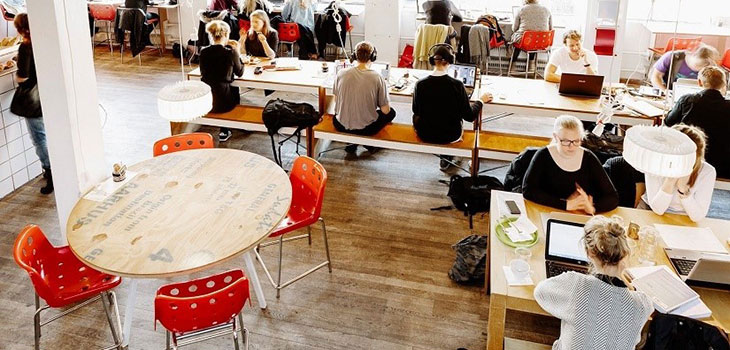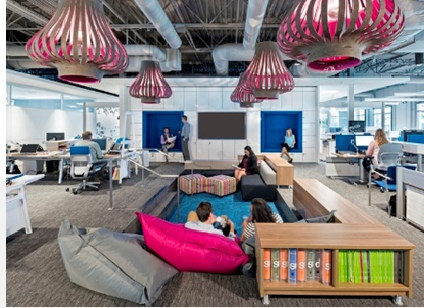
The DNA of office design
More than anything, IT technological developments have redefined function and form of the business office. People manage their email inboxes on the commute into work, collaborate digitally and increasingly lack proximity to each other to be productive. But experts are convinced that that business centers can and should be even sharper to ´refurnish´ - to respond faster to changing times, trends and needs.

"Serviced offices need a rethink," the English business developer Philip Grace maintains. Between 2009 and 2014, Grace founded i2 Office andgrew it to be one of the largest providers of updated serviced office space in the UK, with 30 buildings and 10,000 workstations.
"Today tenants and clients no longer need and require just a ´business centre´, but a centre to do business. Not an office, but a location to work where and when they need it."
Networking and interaction
Amongst her other work-intensive projects, Danish architect Sofie Ladefogedhas developed the shared office ´Lynfabrikken´ (´Lightning Factory´) in a former factory building in the central part of Denmark´s second largest city, Aarhus. She is focused on all the latest trends, demands and opportunities for the modern office space
"I mainly chose to workhere because of the abundant opportunitiesto network andinteractwitha lot of other creative, interesting people from a variety of small industries," Sofie Ladefogedtold the NINEtoFIVE Magazine.
"Nowadays many people choose to work from a serviced office because they don't need a traditional office space for storage. When I leave from work, my office is practically empty - my ´filing cabinet´ with books, trade magazines and that kind of professional materials are all stored on my laptop.
People primarily choose to work from an updated shared office because of the opportunities for cohesion and natural interaction with the site's other users: shared reception, print room, lunch forum, meeting rooms and the workstations, which are perhaps designed as open offices."
Perfect growth engine
Sofie Ladefoged argues that the the basic requirements for a modern office space are a balance of aesthetics: the right architecture, design, interior decor and a professional climate with rich opportunities for social interactions and creative knowledge. It's economies of scale meets social networking, rolled together in a ball of cool."The right architectures and precise decors can greatly help to increase creativity and collaboration among the site's tenants and users of all kind. I often see how so-called ´introvert´ IT geeks thrive and even get tremendous personal boosts of confidence from interacting closely with the business centre´s other users."
The DNA
When approaching and starting to arrange the interiors of a new serviced office space Sofie Ladefoged always aims to identify the locations ´DNA´ through these four central questions. Which building? It's vital that they have the right history, central and accessible location and opportunity for custom architecture. The Lightning Factory's location is ideal, as was the 'entrepreneur's church', a former Greek Orthodox Church in central Stockholm that became an office space for the city's most innovative businesspeople.
The second question is who should be attracted? Although Ladefoged makes it clear that good serviced offices feature the chance to collaborate within and between industries, often special facilities need to be provided for special professional groups, or industries such as design where specialist printing equipment is required.

The third is perhaps the most important - how many workstations? Ultimately, the office will only be successful if it can accommodate the number of people that wish to work there, and the building size and number of stations will affect the layout of the building, its space utilisation and the type of furniture.
The last is the practical one: how big is the budget? There are many opportunities for optional added extras in designing a radical workspace, and budget determines the quality of materials, furniture and artwork
Identity and narrative
When setting out on a new project, the history of the building is important to Sofie. "It's historical setting or context, that defines how I find the architectural potential of an upcoming serviced office space - its DNA - and how I´ll be able to design its decor and profile," she says.
"Shared offices must have an identity that reflect the building's location. I always aim to define its DNA and create the rooms and design based on the building´s own character.
The metamorphosis of the office will continue in the years to come and into the 2020s - from the former shelves and cabinets into creative ´private house´: offices generating lots of social and natural interaction."
Read more about the design, decor and DNA of the modern serviced office:
How Technology Is Changing The Workplace
Philip Grace: Why Serviced Offices Need a Rethink
Get inspired of the new hottest office designs on Officesnapshots.com
Sofie Ladefoged | Architecture and Interior Design
The shared offices of LYNfabrikken in Aarhus


